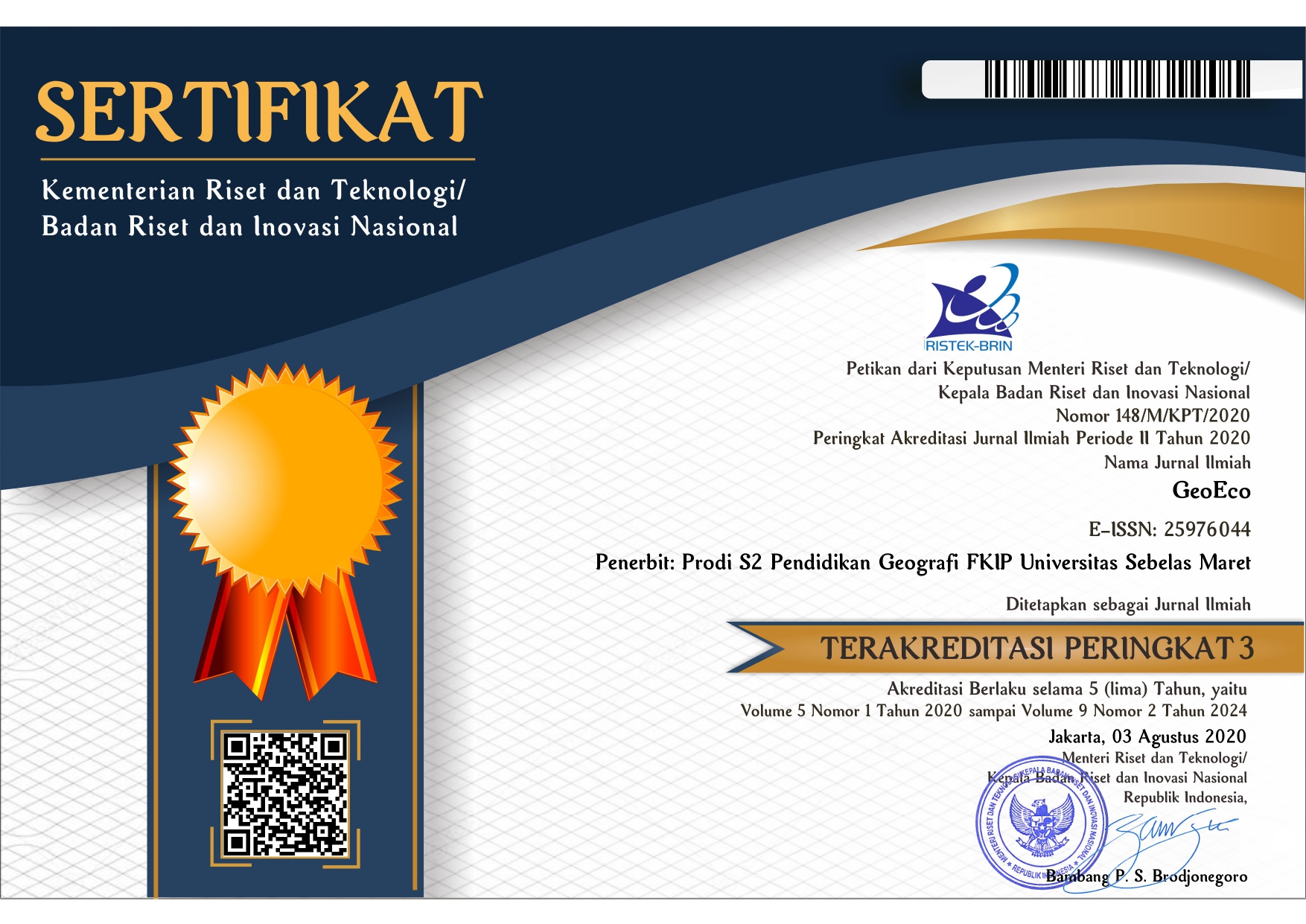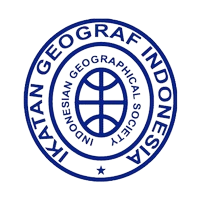GEOGRAPHIC RHYTHM STUDY SCULPTURE AND CARVING ART INDUSTRY JEPARA DISTRICT CASE STUDY IN MULYOHARJO VILLAGE
Abstract
The purpose of this study is to find out geography rhythm procurement of raw materials, marketing destination, and problems with production factors sculpture and carving industry in the center of the sculpture and carving industry center in Mulyoharjo Village, Jepara District. This study uses a qualitative descriptive method. The respondent is a sculpture and carving industry entrepreneur in Mulyoharjo Village whose population is 104 industries and 30 industries are sampled. Data collection by interview, documentation and observation. Data analysis used a descriptive qualitative interactive model technique. The results of the study concluded that 86.6% of the industries experienced capital problem,73.3% of the industries experiences raw material problem, 66.6% of the industries experiences marketing problem, and 73,3% of the industries experiences finding workers problem. The most difficult workforce to find is engraver because absence of engraver regeneration. The raw materials used are teak wood and tamarind. In 1990 the raw material came from Jepara. In 1997-2005 the origin of raw materials expanded into the Java Island region. In 2006-2019 the origin of raw materials moved out of Java. The current availability of wood is not experiencing scarcity but the price is increasing. In 1990-1992 the destination areas for product marketing were in the Jepara Regency area only. In 1993-1995 product marketing could reach big cities in Indonesia. Marketing of products to international markets occurred in 1996 until now. In 2013 the number of exports increased with a value of 7,505,772.91 US $. In 2014 to 2018 the number of exports decreased.
Keywords
Full Text:
PDFReferences
Asare R A., Kyei A., & Mason, J J. 2013. The community resource management area mechanism: a strategy to manage African forest resources. Philosophical Transactions of The Royal Society B, Vol 368 Issue 1625 pg 1-9. https://doi.org/10.1098/ rstb.2012.0311 Banks, M & O’Connor, J. 2009. After the creative industries. International Journal of Cultural Policy, Vol 15 Issue 4, Pg 365-373. Creswell, John W. 2013. Research Design. Terjemah, Achmad Fawaid. Yogyakarta: Pustaka Pelajar. Dinas Perindustrian dan Perdagangan Kabupaten Jepara. 2019. Edensor, Tim. 2009. Geography of Rhytm : Nature, Place, Mobilities, and Bodies. United Kingdom: MPG Group Books. Eskak, Edi. 2013. Krisis Bahan Baku Seni Kerajinan Kayu Di Jepara Dan Solusi Pemecahannya. Dinamika Kerajinan dan Batik, Vol 30 (2), hal. 73-84 Flew, T dan Cunningham, S. 2010. Creative Industries after the First Decade of Debate. The Information Society, 26 (2), pg. 113-123. Garnham, N. 2005. From cultural to creative industries: An analysis of the implications of the ‘creative industries’ approach to arts and media policy making in the United Kingdom. International Journal of Cultural Policy, Vol 11 Issue 1, pg. 15-29. Gibson, C dan Homan, S. 2004. Urban Redevelopment, Live Music and Public Space: Cultural performance and the re‐making of Marrickville. International Journal of Cultural Policy, Vol 10 (1), pg. 67-84. Howkins, J. 2001. The Creative Economy: How People make Money from Ideas. London: Penguin Press. Lewis, D K. 1966. An argument for identity theory. The Journal of Philosophy, Vol 63 (1) pg. 17-25. Lussault, M. 2003. The Sense Of Movement: Modernity and Mobilities in Contemporary Urban Societies. Paris: Centre culturel international de Cerisy-laSalle, Institute pour la ville en mouvement. Morzillo, A T., et, al. (2015). “Communities in the middle”: Interactions between drivers of change and place-based characteristics in rural forest-based communities. Journal of Rural Studies, Vol 42, pg. 79 –90. Mundofar, et. al. 2014. Penataan Koridor Sentra Industri Patung Dan Ukir Desa Mulyoharjo Jepara. Skripsi. Semarang: UNDIP. O’Connor, J. 2012. Surrender to the Void: Life after Creative Industries. Cultural Studies Review, Vol 18 (3), pg. 388-410. Palomo I, et. al. 2014. Incorporating the social-ecological approach in protected areas in the Anthropocene. BioScience, Vol 64 Issue 3, pg. 181–191. Panda, D K. 2019. Role of Identity In The Business Ecosystem: An Inquiry In Indian Stone Carving Clusters. International Journal of Organizational Analysis, Vol 27 (4), pg. 1168-1190. Prastiyan, Damas. 2009. Dinamika Industri Seni Ukir Jepara 1989-2009. Jurnal Risalah, Vol 4 (5). Undang-Undang Nomor 3 Tahun 2014 tentang Perindustrian.
Refbacks
- There are currently no refbacks.












.png)

